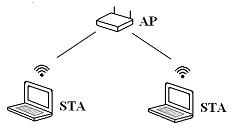Wireless network modes
Join a network
The NL241 can be configured to join an already established infrastructure wireless network (WLAN) (see Infrastructure network). An infrastructure wireless network is one in which all devices or stations (STA) communicate through an access point (AP). This AP will typically connect the wireless network (and the NL241) to a larger wired company or home network and/or the internet. The AP device also controls and routes all the traffic on the wireless network. Once the NL241 has successfully joined the existing wireless network, it can communicate with other devices on the network.
The AP, furthermore, controls security for network access, the wireless frequency (channel) to use, and has the pre-established Service Set Identifier (SSID) for the wireless network. The SSID (or network name) and password/key (if required) can be obtained from your network administrator.
Create a network
The NL241 can be configured to create a network. In this mode, it acts as the access point which other Wi-Fi enabled devices can join. If this configuration is enabled, the user may set an SSID (network name) and password. If a password is supplied, the network created will be secured by WPA2 encryption. If no password is supplied, the network created will be an open network with no encryption.
If this mode is selected, the channel may be specified manually using the Channel setting in the Settings Editor. If the Channel setting is left at the default setting Auto, the device will only use channels 1, 6, and 11 on which to operate to minimize interference from other networks detected in the area.
When manually selecting a channel, it should be noted that two Wi-Fi networks operating on the same channel will interfere with each other and will have to compete for bandwidth. The center frequencies of adjacent channels are 5 MHz apart and the bandwidth of each channel is 20 MHz which means that adjacent channels overlap. To completely avoid interference there must be a spacing of at least 5 channels between each Wi-Fi network. It is therefore recommended to use channels 1, 6, and 11. For a list of all the wireless networks in the area and the associated channels on which they operate, see the Settings Editor > Wi-Fi Wireless Networks in Area box.
A network created by the NL241 supports up to 8 joinees.
DHCP server in a created network
When configured to create a network, the device will run a DHCP server to assign addresses to joinees of the network. The beginning address of the DHCP server pool is the address of the device plus 100. In the case that the device address ends in 135 or above, the beginning address of the DHCP server pool is the address of the device minus 100. There are 20 entries in the DHCP server pool, thus the ending address in the pool is the beginning address plus 20. By default, the device uses a server address of 192.168.67.1. In this case, the pool of addresses is 192.168.67.101 – 192.168.67.120. If the device address is 192.168.67.135, the pool of addresses would be 192.168.67.35 – 192.168.67.55. Any connecting devices running a DHCP client will be assigned an address in this range. If static IP addressing is desired, assign addresses outside of the range of the DHCP address pool (while observing the network mask).
If an IP address is supplied in the IP Address user setting, that address will be used as the DHCP server address. The beginning address in the DHCP server pool will still be the address of the server plus or minus 100. The ending address in the pool will be the beginning address plus 20.
